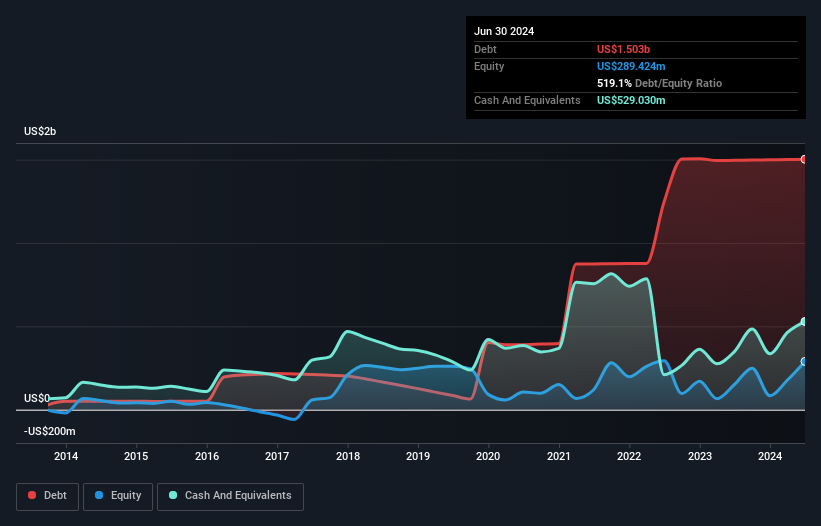- United States
- /
- Biotech
- /
- NasdaqGS:HALO
Halozyme Therapeutics (NASDAQ:HALO) Has A Rock Solid Balance Sheet

Legendary fund manager Li Lu (who Charlie Munger backed) once said, 'The biggest investment risk is not the volatility of prices, but whether you will suffer a permanent loss of capital.' When we think about how risky a company is, we always like to look at its use of debt, since debt overload can lead to ruin. We note that Halozyme Therapeutics, Inc. (NASDAQ:HALO) does have debt on its balance sheet. But is this debt a concern to shareholders?
Why Does Debt Bring Risk?
Debt assists a business until the business has trouble paying it off, either with new capital or with free cash flow. Part and parcel of capitalism is the process of 'creative destruction' where failed businesses are mercilessly liquidated by their bankers. However, a more common (but still painful) scenario is that it has to raise new equity capital at a low price, thus permanently diluting shareholders. Having said that, the most common situation is where a company manages its debt reasonably well - and to its own advantage. When we think about a company's use of debt, we first look at cash and debt together.
Check out our latest analysis for Halozyme Therapeutics
How Much Debt Does Halozyme Therapeutics Carry?
As you can see below, Halozyme Therapeutics had US$1.50b of debt, at June 2024, which is about the same as the year before. You can click the chart for greater detail. On the flip side, it has US$529.0m in cash leading to net debt of about US$973.5m.

How Strong Is Halozyme Therapeutics' Balance Sheet?
Zooming in on the latest balance sheet data, we can see that Halozyme Therapeutics had liabilities of US$133.4m due within 12 months and liabilities of US$1.55b due beyond that. On the other hand, it had cash of US$529.0m and US$214.5m worth of receivables due within a year. So it has liabilities totalling US$936.5m more than its cash and near-term receivables, combined.
Since publicly traded Halozyme Therapeutics shares are worth a total of US$6.99b, it seems unlikely that this level of liabilities would be a major threat. However, we do think it is worth keeping an eye on its balance sheet strength, as it may change over time.
We measure a company's debt load relative to its earnings power by looking at its net debt divided by its earnings before interest, tax, depreciation, and amortization (EBITDA) and by calculating how easily its earnings before interest and tax (EBIT) cover its interest expense (interest cover). Thus we consider debt relative to earnings both with and without depreciation and amortization expenses.
Halozyme Therapeutics's net debt to EBITDA ratio of about 2.0 suggests only moderate use of debt. And its strong interest cover of 46.2 times, makes us even more comfortable. We note that Halozyme Therapeutics grew its EBIT by 23% in the last year, and that should make it easier to pay down debt, going forward. There's no doubt that we learn most about debt from the balance sheet. But ultimately the future profitability of the business will decide if Halozyme Therapeutics can strengthen its balance sheet over time. So if you're focused on the future you can check out this free report showing analyst profit forecasts.
Finally, a company can only pay off debt with cold hard cash, not accounting profits. So we always check how much of that EBIT is translated into free cash flow. Over the last three years, Halozyme Therapeutics actually produced more free cash flow than EBIT. That sort of strong cash generation warms our hearts like a puppy in a bumblebee suit.
Our View
Halozyme Therapeutics's interest cover suggests it can handle its debt as easily as Cristiano Ronaldo could score a goal against an under 14's goalkeeper. And that's just the beginning of the good news since its conversion of EBIT to free cash flow is also very heartening. Zooming out, Halozyme Therapeutics seems to use debt quite reasonably; and that gets the nod from us. While debt does bring risk, when used wisely it can also bring a higher return on equity. There's no doubt that we learn most about debt from the balance sheet. However, not all investment risk resides within the balance sheet - far from it. To that end, you should be aware of the 2 warning signs we've spotted with Halozyme Therapeutics .
If you're interested in investing in businesses that can grow profits without the burden of debt, then check out this free list of growing businesses that have net cash on the balance sheet.
Valuation is complex, but we're here to simplify it.
Discover if Halozyme Therapeutics might be undervalued or overvalued with our detailed analysis, featuring fair value estimates, potential risks, dividends, insider trades, and its financial condition.
Access Free AnalysisHave feedback on this article? Concerned about the content? Get in touch with us directly. Alternatively, email editorial-team (at) simplywallst.com.
This article by Simply Wall St is general in nature. We provide commentary based on historical data and analyst forecasts only using an unbiased methodology and our articles are not intended to be financial advice. It does not constitute a recommendation to buy or sell any stock, and does not take account of your objectives, or your financial situation. We aim to bring you long-term focused analysis driven by fundamental data. Note that our analysis may not factor in the latest price-sensitive company announcements or qualitative material. Simply Wall St has no position in any stocks mentioned.
About NasdaqGS:HALO
Halozyme Therapeutics
A biopharmaceutical company, researches, develops, and commercializes of proprietary enzymes and devices in the United States and internationally.
Solid track record and good value.
Similar Companies
Market Insights
Community Narratives



